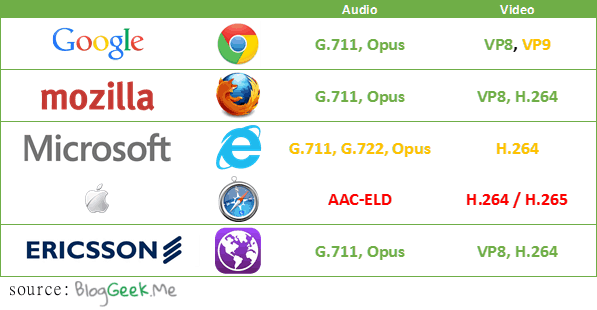This is bigger than Skype or Microsoft IE.
As with any big news related to WebRTC, I was too busy yesterday to deal with it. Taking part as the chair in Informa’s WebRTC Summit in Berlin had priority. Now, back at home after a red eye flight, I’d like to share my opinion about it.
The big news yesterday came on Skype’s blog. Microsoft made it “official” that they are adding ORTC to Internet Explorer. Many have regurgitated what was written on that post. The only good analysis about this came from Dean, who supplied us with a list of open ended questions about WebRTC @ Microsoft.
I won’t repeat Dean’s questions – they are all good ones that I’d like answered as well. What I want to tackle here is how this affects the other players and the recent moves we’ve seen.
Ignoring Opera and adding Ericsson into the mix, this is the evolving picture thus far:

- Green indicates that the specific browser already has support of that codec
- Yellow indicates that the specific browser vendor have made it publicly known that he plans on supporting that codec
- Red indicates my own interpretation on where that vendor leans in that codec
The picture now is starkly different than how it looked like just half a year ago.
Google continues with its original stance of supporting royalty free codecs only. The difference is its shift towards adding VP9 to Chrome. This improves video quality drastically and in some ways changes the conversation from VP8 vs H.264 to some other conversation.
Google is trying to position the conflict as VP9 vs H.264, but I think this will quickly transition to VP9 vs H.265.
Mozilla
Mozilla decided to hook up with Cisco on this one and offer their openH264 as part of the Firefox browser. A technical reason I heard was supporting low end smartphone chipsets, where the Firefox OS is headed. I think it has to do with trying to find more sponsors besides Google, who make up 90% of their revenues.
I do hope for Mozilla that Cisco pay for this support handsomely.
Microsoft
Microsoft has been leaning towards WebRTC for quite some time. The last we’ve heard up until now was the adoption of GetUserMedia in some future version.
Now they announced publicly supporting ORTC. Still, in some future version. The codecs selected by Microsoft include H.264 and G.722 and at least for now preclude VP8.
The inclusion of G.722 is surprising, and was either added for interconnecting to existing Lync/enterprise deployments with HD voice or to HD voice on cellular networks without the need for transcoding.
The selection of H.264 is expected of Microsoft at this point, as their stance on the subject hasn’t changed.
The target for Microsoft at the moment is most probably to bring Skype (and Lync) to the browser and NOT to open it up for interoperability.
Apple
Apple being Apple have said nothing about WebRTC.
They did, however, add H.265 to FaceTime.
My assumption is that Apple will come out with WebRTC at some point in the future. When it does, it will be with H.264 and H.265 support, ignoring the VPx codecs altogether.
For voice, Apple might play nice and use Opus or it might go with its AAC-ELD audio codec that it uses for FaceTime.
Ericsson
Ericsson released their own open source WebRTC project called openWebRTC and revived their Bowser browser in the process. This brings them back to the negotiation table as a formidable player.
As Mozilla, Ericsson took the route of supporting both VP8 and H.264. In the past, Bowser supported only H.264, but times have changed.
If this initiative was synchronized with Microsoft’s I’d assume VP8 wouldn’t have made it into the published code.
It positions Ericsson nicely with an alternative WebRTC client implementation that is more… liberal.
More on Ericsson’s openWebRTC next week.
Where is Opera?
Opera are a UI layer on top of Chromium, which is essentially Google’s Chrome implementation.
They are not a player in the decision making processes that are WebRTC as far as I can tell.
It is why they bring no leverage to the table.
Why is this important?
- WebRTC is now a widely accepted technology. It is just a matter of time until complete browser coverage will be available
- For a technology that is 3 years old, that’s fast
- That said, video codecs are going to stay a challenge in 2015 for WebRTC, with different vendors picking up sides in this battle

Microsoft’s decision to include G.722 has effectively zero impact upon the need to transcode calls to/from wireless handsets. None of the wireless carriers are using G.722. Whether over HSPA+ or LTE, they are basically all using G.722.2 (aka AMR-WB) which is something entirely different, and carries a hefty license arrangement.
Sprint, ever the outlier, is the exception, having deployed the EVRC-NW codec on their CDMA 1X Advanced network. Sprint’s LTE network presumably makes use of AMR-WB, since that’s the standard in that realm.
G.722 seems likely to be a accommodation of wireline HDVoice, perhaps including Lync.
I stand corrected.
From other comments on G+ and Facebook, it does seem that Firefox also has G.722 and Chrome comes with iSAC.
uhm… not sure where you see g.722 in Firefox. Possibly only for “hello”?